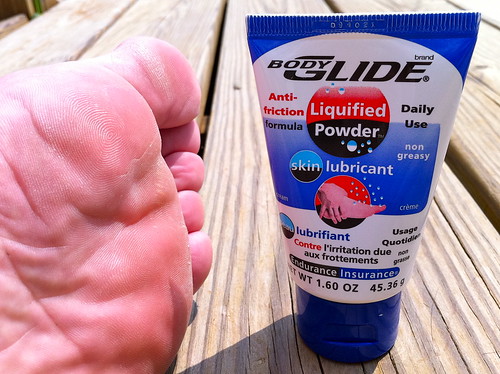There's nothing quite like excitement of gearing up, choosing a great hike route and hitting the trails! There's also nothing quite like that annoying feeling of a hot spot on your heel while trying to hit the summit. Blisters, though I'm sure everyone has experienced the fluid-filled pockets of evil at some time, develop from prolonged friction to a specific area.
A nasty blister can put a damper on a great day hike - or not, if you know how to treat and prevent them.
Prevention is often mixed with hindsight. All too often you hear on a trail "I probably should have worn these new boots before this hike." And it's true, you definitely should. The first step in prevention of blisters is this:
1) Fit your footwear properly:
In hiking footwear you want to have a boot that fits properly with enough space to account for any possible swelling or adding a thicker or extra pair of socks. Have the boot support your foot with no heel slippage, but also have enough room for your toes to wiggle or "play the piano" as some might say. Even though many hiking boots are now made with a higher content of synthetic material, and need "less" break in time; you STILL need to take them out for a walk.
2) Good Socks
We at The Radical Edge swear by Merino socks. These socks are made for conquering blisters. The material is an all natural fibre made of keratin, the same fibre found in your hair and nails! Merino is the wool that is found on the backs of Merino sheep, native to New Zealand. But unlike traditional wool, it breathes in the heat and is extremely soft because unlike traditional wool, the fibres are much smaller and smoother - no itch. The merino literally keeps sweat away by turning it to vapor and pushing it out of the fabric, rather than wicking. But! If you are unconvinced by merino socks (Smartwool & Icebreaker) you can always try a wicking synthetic sock - our two mottos: "Cotton is Rotten" or "Cotton Kills." It's a great house for bacteria and leaves you feeling clammy. Better yet, if you go with a synthetic sock, try toe socks for more protection.
It is important to invest in footwear and socks that work well in ventilating your feet. Warmer, sweaty feet tend to blister more easily, similar to when you boil a pepper and the skin is easy to peel - yeah, skin peels much like that too because it is layered. Gross.
 |
| I warned you about it. This can happen. |
So, if in the event that you are cursed with a blister, here are some ways to take care of it, rather than letting it take care of you!
Moleskin:
Moleskin can be your best friend when it comes to preventing blisters. Especially during break in time, if you are walking trails and you notice a hotspot anywhere on your feet, take a piece of Moleskin (Adventure Medical Moleskin Packs) and unstick the adhesive and place it on the area of your foot that is rubbing. What else can really do the trick in a pinch is duct tape (Lucky Du
Liquid Powder:
Liquid powder keeps the skin from getting clammy (remember that pepper metaphor?) Put liquid powder on the affected area to protect against rubbing and preventing blisters.
Petroleum Jelly:
This is an inexpensive way to lubricate your piggies; however most times Vaseline and other petroleum jellies don't normally last, so you end up reapplying often and the texture of it on your feet isn't the greatest, but it can do the trick!
Things you shouldn't do with a blister:
-pop it. This can lead to dirt and bacteria getting under the skin and infecting the area. That's nasty. Although this is a pretty debatable argument it is best to let the blister drain on its own then bandage it up immediately.
Now, go forth and hike until your legs couldn't possibly carry you any further! Just follow these simple steps and you can conquer any trail you need..sans pain!







No comments:
Post a Comment